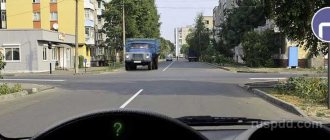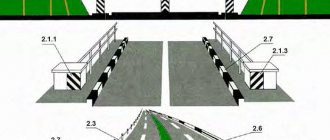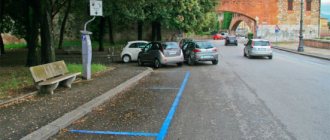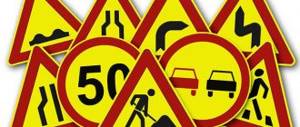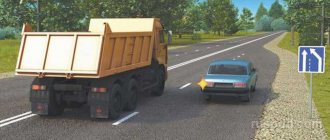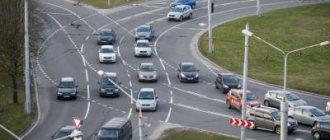Good afternoon, dear reader.
This article will focus on the term "interference from the right", which means that you are required to give way to vehicles approaching from the right.
In the previous article, “Interference on the right when changing lanes,” the application of the rule when changing lanes at the same time was discussed.
Today we will consider the application of this rule at intersections:
- Rule "Interference on the right".
- Obstacle on the right at equivalent intersections.
- Obstruction on the right at unequal intersections.
- Interference on the right in other situations.
Let's get started.
What is interference on the right?
Answering the question of what is an obstacle on the right, it can be noted that all drivers without exception know the “right hand” rule. People turn to him for help in a large number of different situations.
Here are the most basic traffic rules: obstacle on the right:
- When crossing an unregulated intersection of roads of equal status.
- When driving around in parking lots and at gas stations.
- In the process of changing lanes, cars moving in the same direction, but on different lanes of the road.
In this article you can recall the driving school and the features of the “interference on the right” rule. You can find out what it is and in what situations it can be used.
It’s worth noting right away that the traffic rules completely lack such generally accepted terms among drivers as “right-hand rule” and “interference on the right at an intersection.”
In fact, these are, at a conditional level, simplified expressions of clause 8.9 of the Russian Traffic Regulations. Its essence lies in the fact that the rules cannot specifically regulate all situations that arise on the road regarding who is given priority on the highway.
If the driving sequence was not provided for by the Road Traffic Rules, drivers must pass each other, allowing the driver “interfering” on the right side to pass. Only then will you need to continue moving.
In other words, if along the route a person crosses the path of another vehicle, and if the general order of movement is not stipulated by the traffic rules, he must give way to this car if the car is on the right at the time of crossing.
Priority signs include such indicators as “Main road”, “Intersection with an additional road”, “Give way”, “Driving without stopping is prohibited”, “Take advantage of oncoming traffic”.
The equivalent intersection deserves special attention . This is the usual intersection of routes with equal coverage, as well as those characterized by equal priority.
If there are no priority signs listed above, the “right hand” rule automatically begins to apply between drivers. In this case, the intersection at the automatic level becomes equivalent.
If an obstacle appears to the right of the driver, he gives way; if a car is seen on the left, he is obliged to give way.
The opponent must also act according to this rule. If he encounters an obstacle on the right, he must provide the driver next to him with the right of way.
Thus, if on the highway the priority of movement is not determined by signs, traffic lights and traffic controllers, the “interference on the right in the yard” from the leading driver should receive priority in movement.
If emergency situations arise when this rule is violated, there may be three reasons for this. The person at fault for the accident is not very familiar with the traffic rules. Such drivers believe that since at the last intersection he was driving on the main road, then the situation will repeat in this situation.
In reality, this is not the case, which is why the emergency situation arises. Also, the culprit of the accident may believe that in the process of leaving the dirt road, everyone must let him pass, including those moving on the left.
If driving onto asphalt, the driver must give way to everyone, since the dirt road is in all cases a secondary route . This rule applies to leaving stadiums, parking lots and other similar areas.
Often an emergency situation arises between traffic participants, which arose on the basis that the driver considered that he was not obliged to let the driver pass on the right side for the reason that he was turning left. Rotating in this case does not change anything.
Video: “Behind the wheel.” Traffic rules: obstacle on the right
Examples of situations
If we talk about such a feature as “interference on the right”, traffic rules dictate the behavior of motorists in the following circumstances:
- At an uncontrolled intersection of equal roads, car V is driving straight ahead, and D is to the right of it and is about to turn. If he needs to turn right, both cars can move apart along non-intersecting trajectories. In the absence of such an opportunity, V must yield. You will definitely have to let car D pass when it turns left (the paths will definitely intersect) or also goes straight.
- V and D were driving towards each other. The first one needs to turn left, the second one needs to turn right, that is, they intend to go in the same direction. But for V the main and additional enabling signals are lit, and for D the main red and additional green signals are on. The second is an obstacle to the first on the right. Nevertheless, it is D who must yield, since it is not the right-hand rule that works here, but clause 13.5 of the traffic rules.
- Car V drives along the road past the arch leading from the courtyard. Cars D and L leave from there, the second one being to the right. Car V should go first since it is on the main road. Car D is obliged to let V and L pass. After all, the first is in the priority direction, and the second is approaching from the right. Car L must yield only to V.
We recommend reading about how to avoid accidents when changing lanes. From the article you will learn about the rules for changing lanes, examples of accidents when changing lanes, and fines for violations. And here is more information about who is to blame for an accident on a bend.
The right-hand rule in parking lots is no less important than on the roads. It is worth remembering in any conditions. After all, if you do not give way, it is easy not only to run into a fine, but also to become guilty of an accident.
Features of applying the “interference from the right” rule
The principle of movement described above belongs to the category of universal ones, but you need to clearly know the boundaries of its use. The “right hand” rule, like all other rules, has three mandatory conditions when the rule applies.
They can solve the question of how to determine the interference on the right:
- The trajectories of vehicles must necessarily intersect. In this case, the cars will not interfere with each other and will be able to move safely in the prescribed directions.
- The rule applies to equal participants. None of the participants in the disputable situation, who necessarily strives to pass first, should have a certain status advantageous position equivalent to other participants in the movement. In this case, the principle of the right-hand rule cannot be used in such relationships as vehicle-pedestrian, tram and ordinary car. In this case, the pedestrian and the tram are a participant in the road traffic.
- The general order of travel is not specified by traffic rules. In other words, if this particular rule is planned to be used, traffic rules should not be provided.
Here are some examples of these rules. If a driver leaves the parking lot at the same time as another car, this situation does not have a clear traffic rule . In this case, you must give way to the driver driving on the right, who is an obstacle on the right.
We can consider another case with the simultaneous rearrangement of cars of equal mobility. If a motorcycle is involved in a situation that does not have a right-hand obstacle in the form of a passenger car, it will change lanes first.
As for the driver of a passenger car, he will be the right obstacle for the motorcyclist, and accordingly will be obliged to give way to him.
How to apply
According to the official design, non-contact incidents do not differ from ordinary ones. Therefore, you need to perform all the same actions as in a standard situation, that is, call the traffic police. Registration is not required - one of the conditions for simplified registration is direct interaction of the vehicle.
What to pay attention to
In incidents where there was no collision, as in all other ambiguous accidents, video recordings (primarily) and witness testimony will be of good service. Therefore, pay special attention, make sure that you have video recording the incident, especially if.
It is very important to record in documents the real cause of the accident, that is, a maneuver or other action committed in violation of traffic rules, a car that was not injured, but caused an accident, and, accordingly, the violator’s car itself, as well as road conditions. Because very often, for various reasons, it is reported that the victim driver himself lost control, and the one who provoked it remains innocent.
So you need to be very careful when filling out the documents by the accident employees and not be afraid to express your disagreement with their description of the incident, since otherwise it will be very difficult to compensate for the damage at the expense of the culprit (his insurance company).
Expertise
The uncertainty of the circumstances of the incident often requires a study, which helps to find out whether the drivers’ actions were correct and what exactly caused the incident.
In what cases does “interference from the right” not work?
It is also worth considering the conditions when the concept of “interference on the right” is not relevant, for example, whether the interference rule applies in a parking lot in 2021.
This question was discussed above from the point of view of applying the rule, and here as an answer to the question in which cases it does not apply.
Here are a few situations worthy of attention:
- Inconsistency of status of traffic participants. The term “interference on the right” will be irrelevant if initially the participants in the movement were of unequal status. This may be the current controversial situation between a car and a pedestrian, as well as the situation with trackless vehicles and trams.
- Inequality of priority positions of participants, regulated by road signs, traffic lights and traffic controllers.
The second point is worth considering in more detail using examples . If one driver is on a main road and the other is driving on a secondary road, they will be able to apply the right-hand rule between them. Here, the person driving along the main highway will have priority.
If one driver is moving along the road, and the second is leaving a gas station or a residential yard, the controversial situation regarding the yield of the road cannot be resolved according to the “interference on the right” rule.
According to traffic rules, a person who leaves the adjacent territory is obliged to give way to everyone.
It is worth considering one more situation . One driver moves under a green traffic light, and the driver next to him moves along an additional section of the traffic light.
The initial positions of the two drivers are equivalent, since a person driving onto a nearby additional section with the main prohibiting traffic signal is obliged to let ahead of all those driving to the main permissive traffic light.
There are other situations when the described rule does not “work” . For example, when starting to drive or when reversing, you must first give way to other drivers.
Penalty for violating the “third hand” rule
The table of penalties literally does not contain an article for violating the “interference on the right” rule. But if the requirement to cede the right of priority passage in accordance with the “Interference on the right” rule is not met, certain articles of the Code of Administrative Offenses come into force:
- Article 12.13, part 2 – if the violation occurred at an intersection, the penalty is a fine of 1000 rubles;
- Art. 12.14.h. 3 – violation of the rules of priority travel, with the exception of Art. 12.13 p.m. 3 and 12.17 of the Code of Administrative Offences, as punishment a verbal warning is issued or a fine of 500 rubles is issued;
- Art. 12.17 – it talks about not granting the right of way to a route vehicle or a car with flashing lights on, special. sound signal (siren), external color schemes, here a fine of 500 to 3,000 rubles is issued, or deprivation of the right to drive for 1-3 months, depending on the complexity of the case.
Thus, in the APN protocol, the traffic police inspector will indicate a violation of a specific clause and issue a fine under the appropriate clause of the Code of Administrative Offenses for failure to comply with the requirement to provide priority travel.
The “Interference on the right” rule applies only in cases where the case does not fit within the framework described in the traffic rules.
"Interference on the right" at intersections
The “right hand” rule can also be applied when moving through intersections.
Despite the fact that the traffic rules in section 13 regulate certain rules for driving through intersections, the process, if desired, can be seriously simplified by using the most universal right-hand rule.
This principle can be formulated as follows: given equal opportunities, drivers should pass other vehicles using the “right hand” rule.
Difficulties in using this rule applied at intersections are usually accompanied by some dynamism of road events.
When moving through an intersection, you need to remember situations when applying the “right hand” rule is strongly discouraged.
These are situations with the most clear regulation of a well-structured sequence of movements. Here are the most basic of them :
- "dispute" with a tram . The rail vehicle must pass first because it has priority based on the category of the urban vehicle itself. The rule of interference on the right is not relevant for trams. Trams have priority in all situations;
- initial disparity of positions . If drivers are on the highway in directions of different priority, that is, someone is driving on the main one, and someone on the secondary one, their relationship will not be resolved using the “interference from the right” principle.
This also includes the situation when movement is carried out along an additional section of a traffic light . This situation extends to the main prohibit signal.
Who gives way
To begin with, general rules for law-abiding and correct drivers:
- Let's say you need to change lanes to the left. And at this moment, in the left lane, another car is also making a maneuver. You have the primary right: for your neighbor you are a hindrance on the right, his duty is to give in to you.
- If you are planning to turn left, but your neighbor continues to move straight, he should not let you pass, even though you are an obstacle on the right.
- You both turn, your paths should not cross. Everyone goes their own way, no need to let anyone through.
- It is more difficult to pass through an intersection without regulation: there are controversial situations.
It is important to remember: if you drive straight, let everyone on your right pass; if you want to turn right, wait until all the cars have passed along the road you are crossing.
If you need to turn left, you must yield to everyone on the right; at the same time, you have an advantage over those on the left.
There is one more rule that is not covered by the traffic rules - the “Three D Rule”, or “Give Way to the Fool”. Sometimes it is better to let a hasty boor who cuts you off in a priority area complete the maneuver than to allow an accident.
And now - in more detail on road situations that require compliance with the “interference on the right” rule.
Equivalent intersections
Let us remember when the intersection of roads refers to equivalent intersections:
- If this is indicated by the corresponding warning sign 1.6.
- At the intersection there is a sign indicating the end of the main road (2.2).
- The intersection is formed by roads with the same surface, and priority signs (2.3.1 – 2.5) are not installed in front of it.
Traffic regulations requirement, clause 13.11: a driver driving a vehicle (trackless) gives way to vehicles approaching from the right if they are at the intersection of equivalent roads.
Suppose two circumstances coincide: an intersection without regulation, and it is one of equivalent roads. To drive without violation, you need to remember the traffic police.
Circumstances at the crossroads may turn out like this:
| The driver turns right. | The vehicle's paths do not intersect. There is no need to give in. |
| The driver drives straight. A vehicle is approaching him from the right with the intention of turning right. | If the intersection is wide, in order to pass, the driver passes at the same time as the right vehicle. If there is not enough space, the vehicle must be allowed through. |
| The driver drives straight. A vehicle is approaching from the right in order to go left or straight. | The vehicle must be skipped. |
| The driver turns left, the vehicle on the right makes a right turn. | The paths do not intersect, there is no need to skip. |
| The driver wants to turn left. The vehicle moves to the right and continues to move straight or to the left. | We need to give in. |
You should drive through unequal intersections, taking into account the requirements of the traffic rules, clause 13.10. The clause establishes a requirement for the priority of traffic if the main road (MA) changes direction. In this case, all car owners apply the rules for driving through equivalent intersections (EPI).
The rule applies if road signs are installed:
| The driver is heading along the highway. She changes direction: turns right. | He is inferior to vehicles approaching from the right along the main road. |
| The driver's movement is on a road of secondary importance. She turns right. | He is inferior to all vehicles on the right from the secondary road, and to everyone from the main road. |
When changing lanes
If the driver begins to change lanes, he gives way to passing vehicles that do not change their trajectory. And if passing vehicles begin to change lanes at the same time, the driver gives way to the one on the right. This requirement is established in the Traffic Regulations, clause 8.4.
Let's look at a few examples of correct restructuring of passing vehicles:
| The driver is in his lane. A vehicle from the adjacent lane wants to occupy his lane. | The driver must not give way, despite the fact that the vehicle may be on the right. PPP cannot be applied here. |
| The driver, while driving, intends to start changing lanes into the adjacent lane. In this case, none of the vehicles are rebuilt. | You should wait for a safe moment when all vehicles in the adjacent lane have passed. And only then perform a rebuild. PPP doesn't work. |
| The driver intends to change lanes to his left. The vehicle in the left lane also wants to change lanes. | A vehicle in the left lane gives way to the driver, regardless of where it changes lanes. PPP is in effect. |
| The driver needs to change lanes to the right. The vehicle in the right lane intends to start changing lanes. | The driver remembers the traffic police and gives way. |
Rules for driving through intersections according to traffic rules are discussed in the article: driving through intersections according to traffic rules. Read what the blue markings mean in the traffic rules here.
In the courtyard
If the paths of cars intersect in circumstances where the order is not established, the driver who is approaching from the right by another vehicle gives way. The requirement is established by the Traffic Regulations, clause 8.9.
Such situations are not uncommon in courtyards, parking lots, gas stations: driving around in public places with adjacent territories. There is only one rule here: “Skip the obstacle on the right.”
Important Tips
People moving along an additional route or leaving a residential yard must give way to everyone.
It is advisable to first establish visual interaction with the driver moving on the left side.
In this case, it will be clear what his subsequent manipulations will be. This is not a special universal rule, it is simply a way to show drivers your intention.
If the driver does not react at all, if the speed of his car does not decrease, you must definitely let him pass.
Particularly unbalanced drivers try to teach such stubborn people a lesson and drive directly. You shouldn't do that. This will lead to an emergency. You shouldn’t waste your nerves, time and health trying to prove something.
Where to apply for insurance compensation
Non-contact accidents are a covered event. Therefore, it is quite possible to receive insurance compensation if the culprit is identified.
But one of the requirements for the possibility of direct settlement of losses, that is, receiving compensation from your insurance, is a collision of two cars, that is, contact between them.
Therefore, in case of non-contact accidents, you can only receive compensation from the insurer of the culprit; you are not allowed to contact your own insurance company. This is the official opinion of the RCA, and it is enshrined in judicial practice by the Supreme Court. More on this later.
When changing lanes
Let's move on to the problems of interference when carrying out such a maneuver as changing lanes. The traffic rules have a clear description of this procedure, contained in paragraph 8.4. It states that the driver is obliged to give way to any vehicles moving alongside him in a constant direction. Moreover, if the lane change takes place simultaneously, the driver is still obliged to first let the obstacle pass and only then perform the maneuver.
If you yourself are an obstacle for a moving driver on the right, then traffic rules give you the opportunity to let him pass to change lanes. But if you decide to change lanes yourself, then you will have to wait until they let you through and the interference disappears. It is very important to remember that by not allowing the driver to pass, you create a significant threat to the entire traffic, and risk earning a significant fine and also being penalized for dangerous driving.
When does the rule not apply?
There are situations when the rule simply does not apply. This depends on a number of other prescribed norms.
It is necessary to consider situations according to traffic rules when an obstacle on the right, in fact, is not an obstacle:
- Traffic lights/priority signs. In this situation, there is no need to look at the so-called interference. In practice, flows on such sections of the road diverge to the sides in order to avoid traffic jams.
- The driver must know that he is obliged to let the tram pass in any situation. The tram is considered a special type of transport with its own privileges.
- Cars with special signals. If a car is driving with the signals on, then no matter what light is on the traffic light, who is where, this car must always drive forward without obstacles. If you interfere with such a car, you cannot avoid a fine.
In practice, this rule is not always applied. There are situations when it is necessary to comply with exceptions to the rules prescribed by law from traffic rules.
